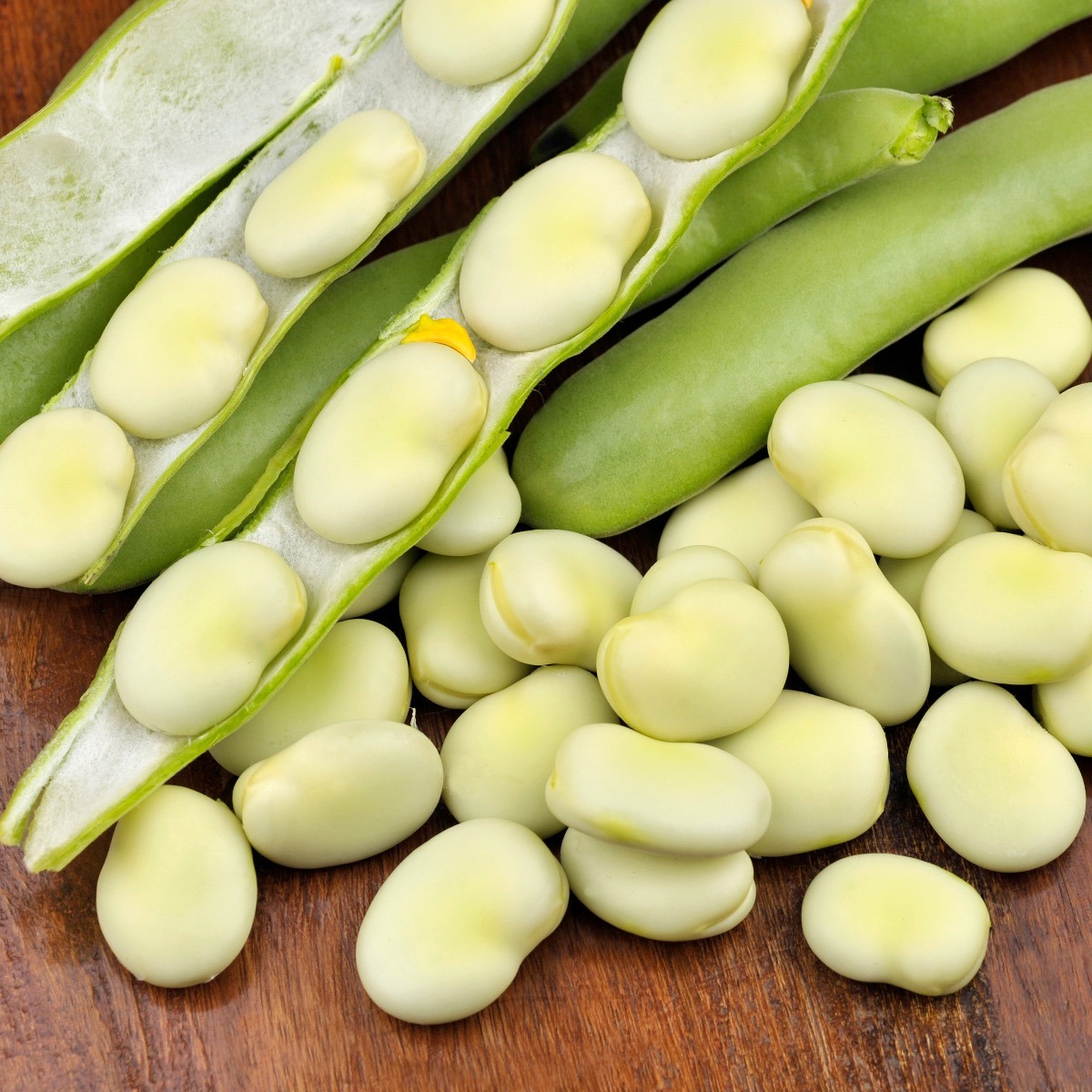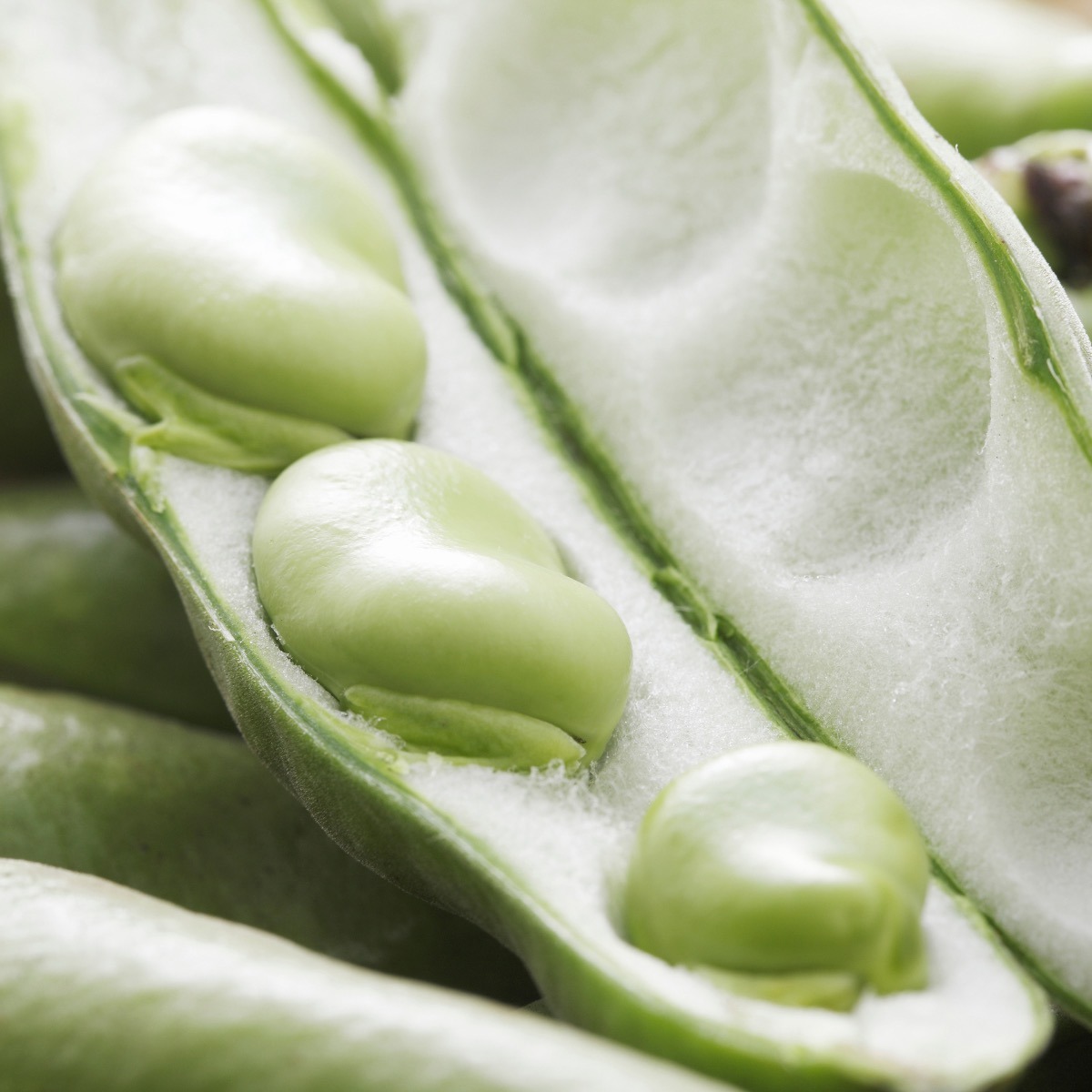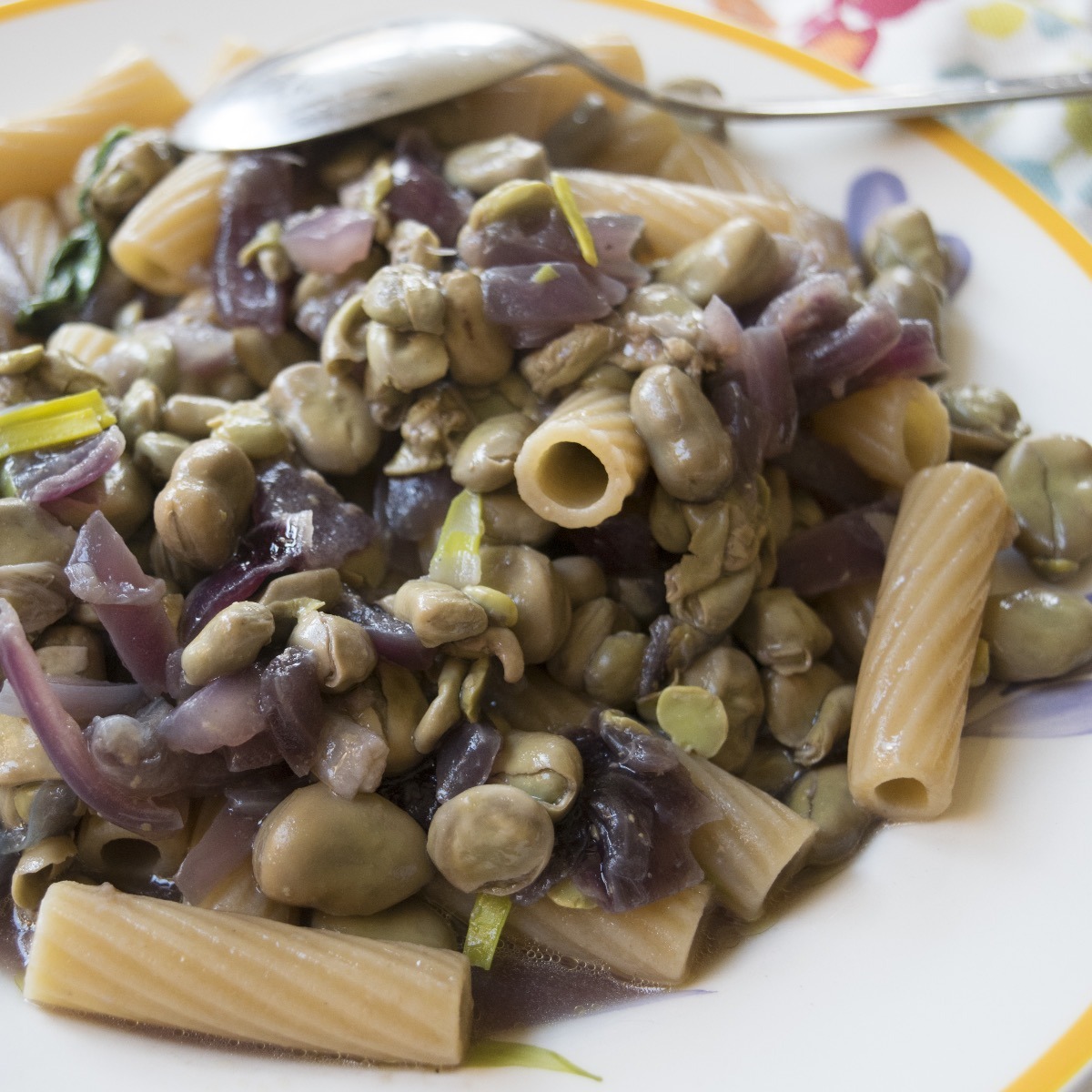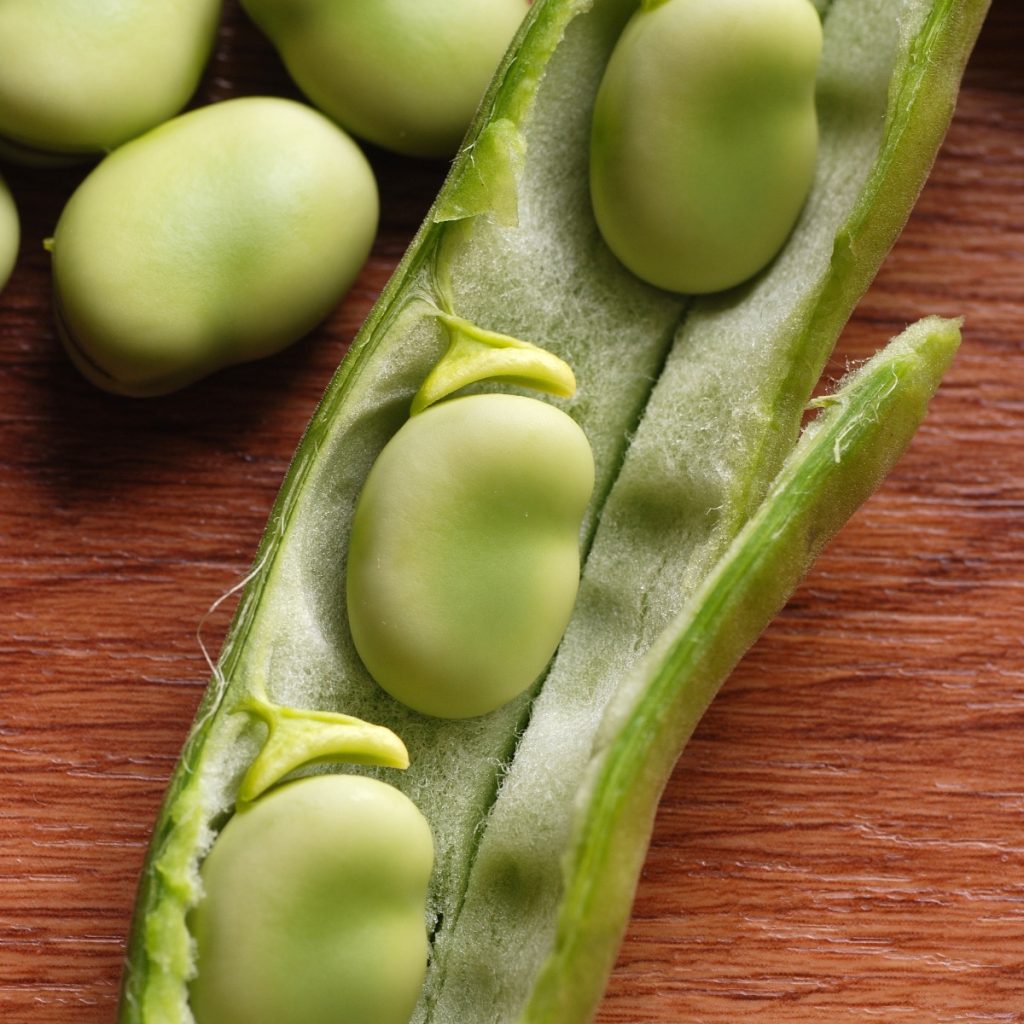“Poor Man’s Meat”
Fava beans are cultivated all over the world. In southern Italy, they are called la “carne dei poveir” or the “poor man’s meat” and are used in many traditional Italian dishes. For example, there is a Sicilian dish called u’maccu prepared for the feast of Sait Joseph on March 19th each year.
What Are Fava Beans?
Fava beans, also known as broad beans, are a legume native to the Mediterranean region. They are large, flat beans encased in a thick, inedible outer shell. Once the outer shell is removed, the beans inside have a creamy, buttery texture and a slightly sweet, nutty flavor.
Fava beans are a popular ingredient in several dishes worldwide and are often used as a substitute for other types of beans in recipes. They are particularly popular in Mediterranean, Middle Eastern, and African cuisines and are often used in dishes such as falafel, hummus, and fava bean puree.
Nutrition
In addition to their use in cooking, fava beans are also a good source of nutrition. They are high in protein, fiber, and several essential vitamins and minerals, including iron, zinc, and folate. They are also low in fat and calories, making them a healthy choice for those looking to maintain a balanced diet.
Fava beans are typically available fresh in the spring, but they can also be found dried or frozen throughout the year. When buying fresh fava beans, look for firm beans with a smooth, unblemished outer shell. Dried and frozen beans should be stored in an airtight container in a cool, dry place and used within a few months for best results.
What Do Fava Beans Look Like?

Fava beans are typically about the size of a small marble and have a bright green color when fresh. They are larger and more elongated than other types of beans and have a smooth, shiny appearance. The outer shell of the bean is thick and slightly fuzzy and is typically removed before the beans are cooked or eaten.
Regarding their appearance, fava beans are similar in size and shape to lima beans, although they are typically a brighter green color and have a slightly different flavor and texture. They are also larger and more elongated than other types of beans, such as kidney beans or black beans.
A Little Broad Bean History
Fava beans have a long and rich history and have been cultivated and eaten for thousands of years. The earliest evidence of fava beans dates back to the Neolithic period, and they were a staple food in ancient Egypt, Greece, and Rome. In these cultures, fava beans were considered a symbol of fertility and abundance and were often used in religious ceremonies and rituals.
According to historical records, fava beans were widely cultivated and eaten in the Ancient Near East, including during the Bronze Age (3300-1200 BC). They were an important food source for many cultures in this region and were often used as a source of protein and nutrition in areas where other types of crops were not as readily available.
In ancient Mesopotamia (located in modern-day Iraq), fava beans were a popular food and were often included in the diet of the wealthy. They were also an important food source for the ancient Egyptians, who used them in a variety of dishes and also ground them into flour to make bread.
Fava beans were also an important food source for many cultures worldwide and were often used as a source of protein and nutrition in areas where other crops were not as readily available. As a result, they were widely cultivated and eaten in several countries, including Italy, Spain, and France, and are still a popular ingredient in many Mediterranean and Middle Eastern dishes.

Other Names for Fava Beans
In addition to their most common name, fava beans are also known by several other names, depending on the region and culture in which they are used. Some other names for fava beans include:
- Broad beans: This is one of the most common alternate names for fava beans and is used in many parts of the world.
- Faba beans: This is another alternate name for fava beans in some regions.
- Vicia faba: This is the scientific name for fava beans and is often used in academic or scientific contexts.
- Horse beans: This name for fava beans is often used in the United Kingdom and other parts of Europe.
- Field beans: This name for fava beans is often used in the United States and other parts of North America.
How Do You Cook Fava Beans?

Depending on the recipe and the desired outcome, there are several ways to cook fava beans, also known as broad beans. Here are a few standard methods for cooking fava beans:
- Boiling: To boil fava beans, remove them from their outer shells and rinse them thoroughly under cold water. Next, bring a pot of salted water to a boil, and add the fava beans. Cook for 5-7 minutes or until the beans are tender. Drain the beans and allow them to cool before using them in a recipe or serving them as a side dish.
- Steaming: To steam fava beans, remove them from their outer shells and rinse them thoroughly under cold water. Place the beans in a steamer basket or on a rack above a pot of boiling water, and steam for 5-7 minutes or until the beans are tender. Allow the beans to cool before using them in a recipe or serving them as a side dish.
- Sautéing: To sauté fava beans, first remove them from their outer shells and rinse them thoroughly under cold water. Heat a small amount of oil or butter in a pan over medium heat, and add the fava beans. Sauté the beans for 5-7 minutes or until they are tender and lightly browned. Serve the sautéed fava beans as a side dish or use them in a recipe as desired.
- Grilling: To grill fava beans, first remove them from their outer shells and rinse them thoroughly under cold water. Toss the beans in a small amount of oil or butter and season with salt and pepper. Preheat a grill to medium-high heat, and place the beans on the grill. Grill the beans for 5-7 minutes or until they are tender and lightly charred. Serve the grilled fava beans as a side dish or use them in a recipe as desired.
Overall, fava beans are a delicious and nutritious ingredient widely used in several dishes worldwide. Their creamy, buttery texture and slightly sweet, nutty flavor make them popular in various recipes. In addition, their high protein and fiber content make them a healthy choice for those looking to maintain a balanced diet.





12 Responses
Really interesting! Thanks. I had a friend who savored them and recall tasting them on one occasion but too long ago to know what my reaction was. Are they related to Edamame?
Edamame are soy beans but I don’t think they are related. – RG
Thanks for the info.I’ve seen FAVA beans in the store but could not find anyone who had ever prepared them.
You are very welcome Betsy. Thanks for commenting. – RG
The VERY BEST FAVA BEAN SALAD! at Publix Supermarket at Plaza del Paraiso, Miami, FL. It is on the “olives/ artichoke hearts, mushrooms, etc” display. It has slivers of red & green peppers, thick virgin olive oil and some kind of herb/s, maybe oregano?
You can just savor them one by one, pick them with an olive pick or a toothpick. It is luscious and creamy. We should ask them for the recipe, try them YOU WILL LOOOVE THEM!
Hi Sonia, I don’t think I’ve ever seen anyone so excited by fava bean salad. Theirs must be great. See if you can find their recipe. – RG
Hi, I love broad beans as they are called in my family, and we have grown and eaten them for probably well over 70 years and at least 3 generations.
We eat them dried and cooked with skins and all, like any other dried bean (you need fibre) I’ve eaten them plain with butter, made into soup, and lately in salads, and other kinds of dishes. I’ve never pureed them yet, but that is on my list. Personally I hate savoury and won’t use it, but go ahead, it does make the beans of any type less gassy! One of my favourite ways to eat beans is to cook the dried beans, very well and thick broth stage (don’t add anything, just let the broth thicken with the falling apart beans) cooled overnight, spread onto thin sliced home made bread (with real butter) and finely chopped fresh onion and light salted beans spread on top. Open face sandwich! YUM!!!
Hi Eva, sounds delicious. Thank you for sharing. – RG
If pre-soaking dried favas, should they be given more time to soak because of the inner jacket around each individual bean? is standard 8 hours good enough?
Hi Nik, the standard overnight soak should be fine for dried fava beans, also called broad bean. Remember, the beans will double in size after soaking so be sure to have a big enough pot. – RG
Hi, I am soaking my dried fava beans right now, but I don’t have 8 hours. I am making Ful the recipe calls for 45 min. of simmering after the 8 hour soak. Can I soak for 6 hours and then just cook of 1 hour? Will they get too mushy?
Hi Archgal, I’m not sure. I say give it a try and see how it turns out. What other choice do you have if you already started soaking the beans. You may want to taste the beans after 45 minutes and see if they are done. If not, continue cooking. Sometimes in the kitchen you just have to experiment and see what works. – RG
I soaked my Italian fava beans the other night, boiled them and took the skins off, a little time consuming to say the least! Am making a salad with peas, fennel and med. soft boiled eggs. To top it off will add crispy prosciutto and some Italian parsley. Bean/fennel and peas are mixed prior in a mustardy vinaigrette and dill, but I am using the fennel fronds as well. I have done a puree/dip with the canned ones, very nice! I use it as a sandwich spread P.S, I always drain and rinse any kind of canned beans.
Hi Rachel, thank you for sharing your tips with my readers. Happy Holiday – RG
Looking to grow these for next year. Do you have a favorite variety to recommend? Thanks
Hi Barbie, I do not have a favorite variety but maybe someone who reads this and does more farming than I can answer your question. – RG
My family name is one of the many southern Italian names beginning with Fava. The legend is that all Sicilians whose name begins with fava descended from one common ancestor.
My last name also begins with fava and my grandfather emigrated from Sicily, so I’ve been trying to figure out it’d there’s any relations between fava beginnings of names and fava beans when I read about them in a book. Thank you for sharing!
Hi Jaclyn, now that’s an interesting coincidence. Not sure but maybe one of my readers will have some ideas.
Fava beans are known to increase oxidative states in the body. In other words, it is the complete opposite to an antioxidant food